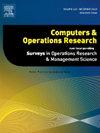高速铁路列车调度与维修综合规划的数据驱动优化方法
IF 4.3
2区 工程技术
Q2 COMPUTER SCIENCE, INTERDISCIPLINARY APPLICATIONS
引用次数: 0
摘要
在铁路系统中,预防性维修计划对于确保列车运行安全至关重要。然而,这些任务经常受到各种干扰(例如,恶劣的天气),导致计划和实际维护持续时间之间的不可预测的偏差,这可能进一步扰乱列车时刻表。与大多数假设维修时间不变的研究不同,本文引入了一种数据驱动的两阶段分布鲁棒优化(DRO)模型,用于列车调度和维修计划的联合优化。在第一阶段,我们确定初始列车时刻表和维护计划。在第二阶段,我们允许对每个车站的列车出发和到达时间进行轻微调整,以适应影响维修工作的干扰。我们的目标是在维护干扰的最坏情况下最小化列车的预期运行时间和与计划时间表的偏差。为了捕获维护干扰的不确定性,我们使用历史数据和Wasserstein度量构造了一个模糊集。我们证明了在Wasserstein模糊集上提出的两阶段DRO模型可以重新表述为有效可解的等效形式。最后,以京广高速铁路为例,将该模型与传统的随机规划方法进行了比较,包括样本平均逼近和鲁棒优化。结果突出了我们方法的效率,并为铁路管理提供了宝贵的见解。本文章由计算机程序翻译,如有差异,请以英文原文为准。
A data-driven optimization approach for the integrated train scheduling and maintenance planning in high-speed railways
In railway systems, preventive maintenance plans are essential for ensuring the safety of train operations. However, these tasks are often subject to various disturbances (e.g., bad weather), leading to unpredictable deviations between planned and actual maintenance durations, which can further disrupt train schedules. Unlike most studies that assume constant maintenance durations, this paper introduces a data-driven, two-stage distributionally robust optimization (DRO) model for jointly optimizing train scheduling and maintenance planning. In the first stage, we determine the initial train schedule and maintenance plan. In the second stage, we allow for slight adjustments to train departure and arrival times at each station to accommodate disturbances affecting maintenance tasks. Our objective is to minimize both the expected travel time of trains and the deviation from the planned schedule under worst-case scenarios for maintenance disturbances. To capture the uncertainty of maintenance disturbances, we construct an ambiguity set using historical data and the Wasserstein metric. We show that the proposed two-stage DRO model, formulated over the Wasserstein ambiguity set, can be reformulated into an efficiently solvable equivalent form. Finally, we apply our model to a real-world case study of the Beijing–Guangzhou high-speed railway and compare it with traditional stochastic programming methods, including sample average approximation and robust optimization. The results highlight the efficiency of our approach and provide valuable insights for railway management.
求助全文
通过发布文献求助,成功后即可免费获取论文全文。
去求助
来源期刊

Computers & Operations Research
工程技术-工程:工业
CiteScore
8.60
自引率
8.70%
发文量
292
审稿时长
8.5 months
期刊介绍:
Operations research and computers meet in a large number of scientific fields, many of which are of vital current concern to our troubled society. These include, among others, ecology, transportation, safety, reliability, urban planning, economics, inventory control, investment strategy and logistics (including reverse logistics). Computers & Operations Research provides an international forum for the application of computers and operations research techniques to problems in these and related fields.
 求助内容:
求助内容: 应助结果提醒方式:
应助结果提醒方式:


